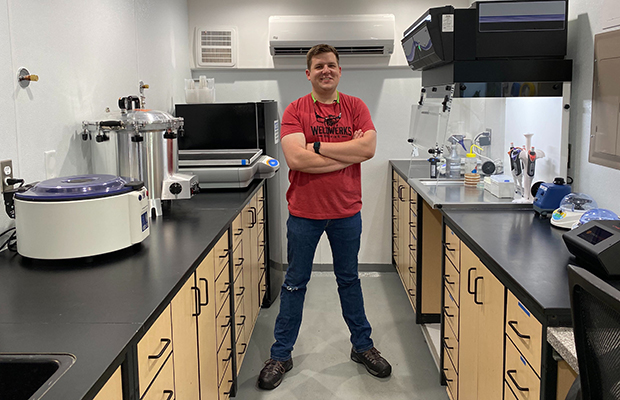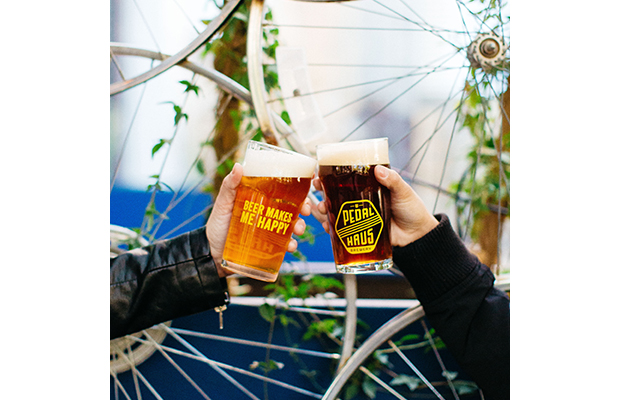
When building up your brewery’s lab, the basics are pretty obvious. A microscope and glassware are among the first purchases, but after that it becomes a serious investment.
Ryan Dunnavent stepped into his current position as CANarchy’s Vice President of Facilities — East earlier this year and splits his days between managing four of the eight craft brewery collective’s labs: Perrin Brewing (Michigan), Cigar City (Tampa), Oskar Blues (Colorado), and his base, Oskar Blues (North Carolina).
Both Oskar Blues labs that Dunnavent oversees started in the 10s of thousands of barrels right from the beginning, so the priority was not just the general health of the beer, but also finding contaminants.
“The hardest part about large-scale production is making the same product every time,” Dunnavent said. “Making beer is relatively easy when it comes down to it, but making the exact same beer every time is where it gets more challenging.”
From the get-go, some large equipment was invested in Oskar Blues, so aside from a microscope and glassware, essential purchases included a UV-Vis Spectrometer, microbiological testing tools, and a steam sterilizer.
One of the most recent additions to three of the four labs was a discrete analyzer, a tool which automates some of the tedious
labor-intensive lab tasks.
“It gives you the ability to run a broader spectrum of tests much more frequently,” Dunnavent said. “An example would be FAN (free amino nitrogen). FAN is probably one of the more powerful ways to assess yourself and also to audit your brewhouse procedures. You can do that test with just some glassware, a water bath, and your UV-Vis spectrophotometer but it’s going to take most or all of the day to get it done.
“And then you’re storing samples and you’re having to pick and choose what you’re measuring. With the discrete analyzer, we’re able to run that on every single batch.”
Another recent big investment was gas chromatography-mass spectrometry.
“That allows us to actually quantify the amount of volatile aroma compounds that are in various beers,” Dunnavent said. “Obviously with hoppy beers that’s incredibly powerful, to know exactly what you’re smelling.”
The next step for the larger labs in CANarchy is high-performance liquid chromatography (HPLC). With more and more beers being dry-hopped, the relied-on IBU metric isn’t as accurate an assessment of dry-hopped beers as HPLC.
“[The UV spectrophotometer] might be one of the first purchases you make that you get excited about because you can measure IBU … but the problem is there’s a physical removal of some of the bitterness compounds when you dry hop. And then there’s additions of other compounds that contribute to the perception of bitterness but it’s a different experience of said bitterness. They’re not always going to be removed and replaced in equal amounts.
“The problem with the IBU test is that it’s going to measure all of them, so you’re going to get one number, but you don’t know what portion of that number is what compound.”
So with HPLC, the lab can measure the compounds individually to get a more accurate assessment of bitterness.
Patrick Combs, Quality Manager and Advanced Cicerone WeldWerks advises that the first big purchase breweries invest in is a laminar flow cabinet.
There are methods in which you can plate without one, but having a clean workspace free of contaminants will save you a ton of headache in false positives,” Combs said. “From there, a lot of people tend to gravitate towards a spectrophotometer to measure things like IBUs, VDKs, SRM, and even Acetaldehyde. But if you don’t have a reliable, carefully calibrated dissolved oxygen meter you are missing out of some of the most valuable data for product quality.”
For a while, the Greeley, Colorado brewery operated its lab out of a small storage closet, but recently expanded into a new lab that now opens up directly into the production area. Building a bigger lab meant needing to run more quality checks. A bigger lab doesn’t come without its downfalls, however. A positive pressure system had to be installed to keep dust and contamination to a minimum.
“The quality program is staffed and run by myself, but this is a great opportunity to illustrate a point that a lot of people tend to miss,” said Combs. “Although the Q/C side can be accomplished without the involvement of very many people, the Q/A portion as a whole is a shared responsibility between everyone in the production area. When quality is at the forefront of everyone’s mind, it makes overcoming obstacles a lot easier.”
With the broad portfolio of beers that Weldwerks brews — including kettle sours — the occasional wild beer project and working with numerous yeast strains, it’s important to be aware of a spoilage organism when it presents itself. So Weldwerks added qPCR technology to its toolkit.
“Knowing what exactly is lurking in your beer greatly aids in the investigation process,” Combs said. “Although you can get most of the way there with selective media, there are always curveballs. In my experience, many adjuncts — fresh roasted coffee for instance — often can introduce non-saccharomyces/non-brettanomyces wild yeast.
“Although it appears to die relatively quickly in-package (usually less than 72 hours), under a microscope it appears incredibly similar to STA1+ strains we use. PCR removes a lot of the guesswork.”




Be the first to comment